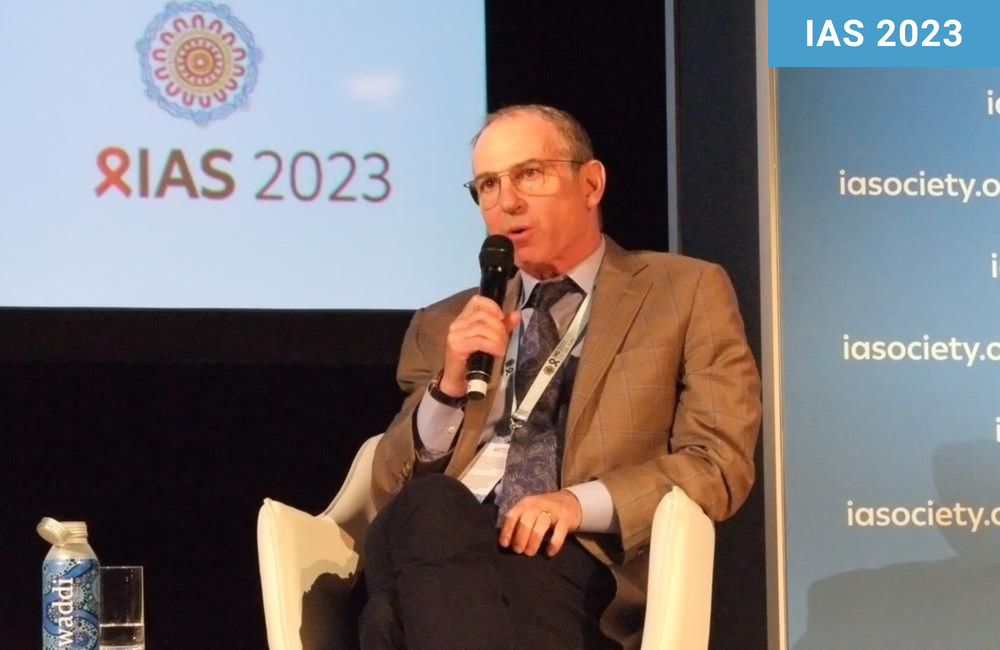
A widely used statin medication reduced the risk of heart attacks, strokes and other cardiovascular events when given to people with HIV who are at low to moderate risk for cardiovascular disease, according to results from the REPRIEVE study presented at the 12th International AIDS Society Conference on HIV Science (IAS 2023) in Brisbane, Australia. The findings suggest that statin use could potentially prevent as many as one in five major cardiovascular events or related deaths.
As previously reported, the large phase III trial was stopped ahead of schedule in April after interim results showed that pitavastatin lowered the risk of major cardiovascular events by 35%. Professor Steven Grinspoon of Harvard Medical School and Massachusetts General Hospital presented detailed results at IAS 2023; they were simultaneously published in The New England Journal of Medicine.
“People with HIV are twice as likely to develop cardiovascular disease, and therefore [the REPRIEVE findings] could have very significant real-world impact,” IAS president and conference co-chair Professor Sharon Lewin of the University of Melbourne said at an advance media briefing.
“We would highly recommend that guidelines be changed” to recommend statin therapy for this population, Grinspoon added.
Cardiovascular disease in people with HIV
A growing body of research shows that people living with HIV are at greater risk for cardiovascular disease (CVD) and outcomes such as heart attacks and strokes. What’s more, excess plaque build-up in arteries occurs at a younger age in this population. Reasons may include chronic inflammation that persists even with effective antiretroviral therapy, adverse effects of certain antiretroviral drugs and higher rates of traditional risk factors.
CVD is associated with elevated cholesterol and triglycerides in the blood. Statins, which bring down low-density lipoprotein (LDL), or ‘bad cholesterol’, have been shown to reduce the risk for cardiovascular events and death in the general population, but their benefits for people with HIV were previously unclear. Statins are also known to lower inflammation, so they could potentially address both traditional and non-traditional risk factors.
“Cardiovascular disease is increasing among people with HIV,” Grinspoon said at the briefing. “Many large epidemiological studies have suggested up to a two-fold increase.” Known risk factors such as smoking and high cholesterol contribute to the disparity, “but there's something beyond the traditional risk – when you account for that, excess risk does not go away.”
REPRIEVE findings
REPRIEVE, the Randomized Trial to Prevent Vascular Events in HIV (NCT02344290), began enrolment in 2015. The largest randomised HIV trial to date, it was conducted at more than 100 sites in 12 countries in North and South America, Europe, Africa and Asia. The study enrolled 7769 people with HIV aged 40 to 75, with a median age of 50. Nearly a third were women, 41% were Black, 35% were White and 15% were Asian.
In an editorial accompanying the REPRIEVE report, Dr Matthew Freiberg of Vanderbilt University Medical Center in Tennessee credited the study team for attempting to enrol participants who have often been excluded from clinical trials, such as those with hepatitis C or mental health conditions and those who use alcohol or drugs.
The participants were on stable antiretroviral therapy and most (88%) had an undetectable viral load. They were largely using regimens containing a non-nucleoside reverse transcriptase inhibitor (47%) or an integrase inhibitor (26%). Half had been on antiretrovirals for 10 or more years. The median CD4 cell count at baseline was 621, though about half had previously had a CD4 count below 200, the threshold for an AIDS diagnosis.
The study participants had no prior history of atherosclerotic CVD and had not previously taken statins. They had demographics, co-morbidities and laboratory values reflecting low to moderate cardiovascular risk, with a median 10-year CVD risk score of 4.5%. The median baseline LDL level was 108 mg/dl (slightly elevated). They had adequate liver and kidney function at baseline.
“We targeted a group that would not ordinarily have been prescribed a statin, or any therapy, who would have been simply told to go home,” Grinspoon said. But research has shown that CVD risk scores developed for the general population can underestimate the risk for people living with HIV.
REPRIEVE participants were randomly assigned to receive oral pitavastatin (4mg) or a placebo once daily. They were allowed to start a statin outside the study, if needed, and about 6% in the pitavastatin group and 10% in the placebo group did so.
The composite primary endpoint was major cardiovascular events including myocardial infarction (heart attack), stroke and transient ischaemic attacks, unstable angina (chest pains), peripheral artery disease, revascularisation procedures (such as stents or coronary bypass surgery), CVD-related death or death from an undetermined cause. Participants were also monitored for statin side effects and drug interactions. Pitavastatin, which is not metabolised through the CYP3A4 pathway, is considered safe to use with antiretrovirals.
Over about five years of follow-up, adherence was very good to excellent, Grinspoon reported. LDL cholesterol levels, which were similar at baseline, decreased by 30% in the pitavastatin arm while staying the same in the placebo arm, and this effect was durable over time.
Major cardiovascular event rates were 4.8 and 7.3 per 1000 person-years, respectively, in the pitavastatin and placebo arms. The rate of major cardiovascular events was 35% lower in the pitavastatin arm compared with the placebo arm. Furthermore, the risk of cardiovascular events or death from any cause was 21% lower with pitavastatin (9.2 vs 11.6 per 1000 person-years, respectively).
In comparison, risk reduction has been around 20% across trials evaluating statins for the general population. In the JUPITER trial, a comparable primary prevention study of rosuvastatin that enrolled a much older population of HIV-negative people, the reduction was 44%. According to Grinspoon, the REPRIEVE team had expected about a 30% reduction for these lower-risk people with HIV, which the study exceeded. Lowering LDL alone would have been expected to reduce risk by 17%, he said.
"The size of the effect was 'very consistent' for men and women, across racial/ethnic groups and across most regions."
The overall number needed to treat (NNT), or the number of people who would have to take pitavastatin for five years to prevent one major cardiovascular event, was 106. But for people with low to moderate CVD risk, the NNT was 53 – similar to that seen in JUPITER. For those with a higher risk score (greater than 10), the NNT fell to 35.
“The number needed to treat was smaller the higher your [CVD] risk is. In fact, we were quite impressed that we were able to show this amount of cardiovascular disease and this effect in people who are relatively young with a low baseline risk,” Grinspoon said. “This study reinforces that rates of cardiovascular disease are higher in people with HIV, that they occur in young people with only low to moderate traditional predicted risk…[and that] you can prevent this disease with a statin therapy.”
The size of the effect was “very consistent” for men and women, across racial/ethnic groups and across most regions, although there was a “very potent effect” in south Asia, Grinspoon noted. It was also comparable across CD4 counts and for the small proportion of people with a detectable viral load.
The effect was also similar for people with high or low LDL cholesterol at baseline, indicating that the benefits of pitavastatin go beyond just lowering LDL. “It didn't really matter what your LDL was,” Grinspoon said. “The effect was approximately twice as large as you would anticipate from lowering LDL alone, suggesting additional factors.”
“Ongoing research about how statin therapy may affect inflammation and increased immune activation among people with HIV may help us better understand the additional benefits we’re seeing with this treatment approach,” he added in a press release from the US National Institutes of Health, which supported the study.
Pitavastatin was generally safe and well tolerated. Side effects were similar to those seen in general population studies, and there were no unanticipated safety concerns, Grinspoon reported. Serious adverse events were uncommon and occurred with similar frequency (about 4%) in both the pitavastatin and placebo arms; 2% and 1%, respectively, withdrew due to adverse events.
There were more cases of diabetes in the pitavastatin group – as seen in most statin studies – but the rates were low, about 5% vs 4%, respectively. Muscle-related side effects were also uncommon (about 2% vs 1%) and mostly mild. Only three people taking pitavastatin and four in the placebo group developed rhabdomyolysis, or severe muscle damage; 11 and eight, respectively, had severe ALT elevation (which can indicate either muscle or liver damage). Very few participants left the study due to diabetes or muscle problems.
Study implications
“This research suggests that statins may provide an accessible, cost-effective measure to improve the cardiovascular health and quality of life for people living with HIV,” said Dr Gary Gibbons, director of the US National Heart, Lung, and Blood Institute. “Additional research can further expand on this effect, while providing a roadmap to rapidly translate research findings into clinical practice.”
The REPRIEVE participants, who have already been informed about the trial results, will be followed-up to the end of July. As they have their final visit, they will be offered the chance to receive statin therapy managed by primary care clinicians.
“HIV has been considered a modifier for cardiovascular disease for the past couple of years. The problem is, no one knew what to do with that information, and [doctors] were not necessarily prescribing statins…because there had been no data to show that this was efficacious,” Grinspoon said. “Our data in low to moderate risk groups suggest that the guidelines should be amended to recommend that HIV patients, because they have this excess risk, [should] be offered statin therapy.”
Although pitavastatin targets one and perhaps two important risk factors for atherosclerotic cardiovascular disease (LDL cholesterol and inflammation), Freiberg noted that “other risk factors merit attention for this preventive approach to be transformative,” including cigarette smoking, unhealthy alcohol consumption, drug use, obesity and mental health conditions.
Grinspoon SK et al. Key REPRIEVE results and the utility of statins among people living with HIV: What have we learned? 12th IAS Conference on HIV Science, Brisbane, symposium SY06, 2023.
View the details of the symposium on the conference website.
Grinspoon S et al. Pitavastatin to prevent cardiovascular disease in HIV infection. The New England Journal of Medicine, online ahead of print, 24 July 2023.
DOI: https://doi.org/10.1056/NEJMoa2304146
Freiberg MS HIV and cardiovascular disease — an ounce of prevention. The New England Journal of Medicine, online ahead of print, 24 July 2023.
DOI: https://doi.org/10.1056/NEJMe2306782

